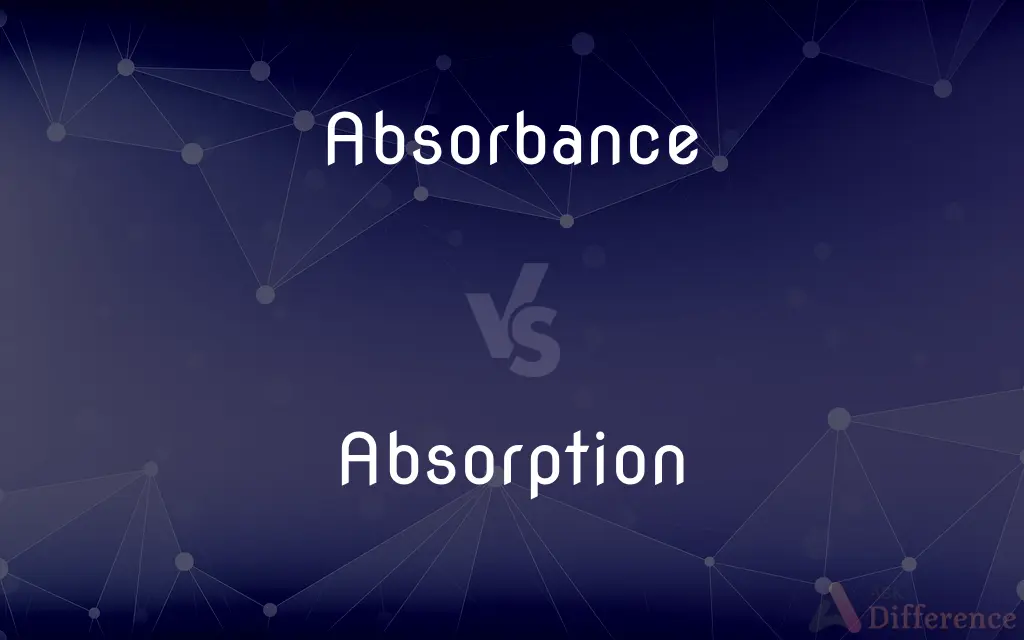Absorbance vs. Absorption — What's the Difference?
By Urooj Arif & Fiza Rafique — Updated on March 7, 2024
Absorbance is a measure of light absorbed by a material, while absorption refers to the process of taking in light or other substances.

Difference Between Absorbance and Absorption
Table of Contents
ADVERTISEMENT
Key Differences
Absorbance, often measured in a spectrophotometer, quantifies the amount of light at a specific wavelength that is absorbed by a sample. It is a logarithmic measure based on the ratio of incident to transmitted light, according to Beer-Lambert law. Absorption, on the other hand, describes the general process by which substances take up or absorb light, energy, or other particles from their surroundings.
While absorbance is a specific, quantifiable value used in analytical chemistry and physics to assess the concentration of a solute in a solution, absorption encompasses a broader range of physical, chemical, and biological phenomena. Absorption can occur across various contexts, such as light absorption by pigments, sound absorption by materials, or the uptake of nutrients by organisms.
The concept of absorbance is crucial in techniques like UV-Vis spectroscopy, where it helps in identifying and quantifying substances based on their light-absorbing properties. Absorption, however, can refer to various mechanisms, including not just light but also gases and liquids by solids or liquids, as seen in applications like gas absorption in liquids for scrubbing or cleaning processes.
Absorbance is determined by factors like the concentration of the absorbing species, the path length of the light through the sample, and the intrinsic absorptivity of the species. In contrast, the efficiency of absorption processes can be influenced by factors such as surface area, temperature, and the nature of the materials or substances involved.
In practical applications, measuring the absorbance of a solution can provide insights into the concentration of a specific solute, useful in fields like biochemistry, environmental science, and pharmacology. Meanwhile, understanding absorption processes is fundamental in designing materials for soundproofing, creating efficient light-harvesting systems, or enhancing drug delivery mechanisms.
ADVERTISEMENT
Comparison Chart
Definition
Measure of light absorbed by a material at a specific wavelength
Process of taking in light, energy, or other substances
Application
Used to quantify solute concentration in solutions
Broad range of phenomena in physics, chemistry, and biology
Measurement
Quantified using instruments like spectrophotometers
Not a singular quantifiable property, varies by context
Influencing Factors
Concentration, path length, intrinsic absorptivity
Surface area, temperature, material nature
Key Uses
UV-Vis spectroscopy, analytical chemistry
Soundproofing, light-harvesting, material design
Compare with Definitions
Absorbance
The ratio of incident light to transmitted light through a substance.
High absorbance values in the sample suggested a greater concentration of the absorbing species.
Absorption
The process by which one substance takes up another substance or energy.
The absorption of sunlight by chlorophyll is essential for photosynthesis.
Absorbance
A value used to assess the purity or concentration of solutions.
The absorbance spectrum helped identify the presence of specific compounds in the mixture.
Absorption
The uptake of sound energy by materials, reducing noise levels.
The material's high absorption rate made it ideal for soundproofing the studio.
Absorbance
An instrumental reading in spectrophotometry.
The spectrophotometer provided absorbance data crucial for the biochemical analysis.
Absorption
A phenomenon where light is taken in and converted to another form of energy.
Solar panels rely on the absorption of light to generate electricity.
Absorbance
A logarithmic measure of the light absorbed by a sample at a particular wavelength.
The absorbance reading at 260 nm indicated the concentration of nucleic acids in the sample.
Absorption
The incorporation of nutrients or chemicals into organisms or materials.
The absorption of nutrients from the soil is vital for plant growth.
Absorbance
A key parameter in Beer-Lambert law used in analytical applications.
By calculating absorbance, the lab technician could determine the solute's concentration.
Absorption
The process of gases dissolving in a liquid.
Carbon dioxide absorption by the ocean plays a significant role in regulating the Earth's climate.
Absorbance
Absorbance is commonly defined as "the logarithm of the ratio of incident to transmitted radiant power through a sample (excluding the effects on cell walls)". Alternatively, for samples which scatter light, absorbance may be defined as "the negative logarithm of one minus absorptance, as measured on a uniform sample".
Absorption
The act or process of absorbing or the condition of being absorbed.
Absorbance
(physics) A logarithmic measure of the amount of light that is absorbed when passing through a substance; the capacity of a substance to absorb light of a given wavelength; optical density.
Absorption
A state of mental concentration.
Absorption
The act or process of absorbing or of being absorbed as,
Absorption
(obsolete) engulfing; swallowing up, as of bodies or land.
Absorption
Assimilation; incorporation.
The absorption of a smaller tribe into a larger
The absorption of bodies in a whirlpool
Absorption
The imbibing or reception by molecular or chemical action, of radiant energy; the process of being neutrons being absorbed by the nucleus; interception.
The absorption of light, heat, electricity, etc.
Absorption
(meteorology) The process in which incident radiant energy is retained by a substance (such as an air mass) by conversion to some other form of energy (such as heat).
Absorption
(physiology) in living organisms, the process by which the materials of growth and nutrition are absorbed and conveyed to the tissues and organs; taking in by various means, such as by osmosis.
Absorption
Entire engrossment or occupation of the mind.
Absorption in some employment
Absorption
Mental assimilation.
Absorption
(electrical engineering) The retaining of electrical energy for a short time after it has been introduced to the dielectric.
Absorption
The act or process of absorbing or sucking in anything, or of being absorbed and made to disappear; as, the absorption of bodies in a whirlpool, the absorption of a smaller tribe into a larger.
Absorption
An imbibing or reception by molecular or chemical action; as, the absorption of light, heat, electricity, etc.
Absorption
In living organisms, the process by which the materials of growth and nutrition are absorbed and conveyed to the tissues and organs.
Absorption
Entire engrossment or occupation of the mind; as, absorption in some employment.
Absorption
(chemistry) a process in which one substance permeates another; a fluid permeates or is dissolved by a liquid or solid
Absorption
(physics) the process in which incident radiated energy is retained without reflection or transmission on passing through a medium;
The absorption of photons by atoms or molecules
Absorption
The social process of absorbing one cultural group into harmony with another
Absorption
The process of absorbing nutrients into the body after digestion
Absorption
Complete attention; intense mental effort
Absorption
The mental state of being preoccupied by something
Common Curiosities
What does absorbance indicate in a solution?
Absorbance indicates the amount of light absorbed by a solution, which can be related to the concentration of a particular solute.
How does temperature affect absorption?
Temperature can influence absorption processes by affecting the solubility, reaction rates, and molecular interactions involved.
What factors affect absorption?
Factors affecting absorption include the nature of the absorbing material, surface area, temperature, and the presence of specific functional groups or structures.
Is absorption always related to light?
No, absorption can involve various forms of energy and substances, including sound, light, gases, and liquids.
What role does absorbance play in spectroscopy?
In spectroscopy, absorbance is used to identify and quantify substances based on their unique light absorption characteristics.
Can absorption be reversed?
Yes, some absorption processes are reversible, such as physical adsorption of gases, while others, like chemical absorption, may be irreversible or require significant energy to reverse.
What is the difference between absorption and adsorption?
Absorption involves the uptake of substances throughout the volume of a material, while adsorption involves the accumulation of substances only on the surface.
Can absorbance be negative?
No, absorbance values are non-negative since they are based on the logarithm of a ratio that is always less than or equal to 1.
How is absorbance measured?
Absorbance is measured using instruments like spectrophotometers, which quantify the light absorbed at specific wavelengths.
How do you calculate absorbance from transmittance?
Absorbance can be calculated from transmittance using the formula A = -log10(T), where A is absorbance and T is transmittance.
Share Your Discovery

Previous Comparison
Decrease vs. Reduction
Next Comparison
Pyrolysis vs. GasificationAuthor Spotlight
Written by
Urooj ArifUrooj is a skilled content writer at Ask Difference, known for her exceptional ability to simplify complex topics into engaging and informative content. With a passion for research and a flair for clear, concise writing, she consistently delivers articles that resonate with our diverse audience.
Co-written by
Fiza RafiqueFiza Rafique is a skilled content writer at AskDifference.com, where she meticulously refines and enhances written pieces. Drawing from her vast editorial expertise, Fiza ensures clarity, accuracy, and precision in every article. Passionate about language, she continually seeks to elevate the quality of content for readers worldwide.













































